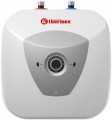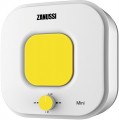Power consumption
Electrical power consumed by the heater during operation.
This parameter is of key importance for electric models (see "Energy source"). In them, the power consumption corresponds to the power of the heating element and, accordingly, the heat output of the entire device. The overall efficiency and flow rate of the water heater directly depend on the useful power. Accordingly, high-flow rate models inevitably have high consumption. At the same time, we note that the heating power is selected by the designers in such a way as to guarantee the necessary flow rate and water temperature. So when choosing a device according to flow rate, you need to look primarily at flow rate and temperature. Power must be taken into account when connecting: for example, if a 220 V model (see "Power source") consumes more than 3.5 kW, it, as a rule, cannot be plugged into a regular outlet — connection is required according to special rules. And the most productive and high-powered models — 10 kW or more — are connected only to three-phase mains.
The power consumption has a similar value for combined boilers — adjusted for the fact that in them the electric heater is an additional source of heat. For gas and indirect models, this parameter describes the power consumption of control circuits and other auxiliary structural elements; this power consumption is usually very small — on the order of several tens of watts, less often up to 1.5 kW.
Tank lining
—
Enamel. Like plastic, enamel is chemically neutral and does not affect the taste and smell of water, while it is considered more durable. Theoretically, this material is prone to the appearance of microcracks, including due to temperature differences (which eventually lead to water contact with metal and corrosion). However, high-quality heat-resistant enamels are most often used in boilers, which have the same coefficient of thermal expansion as the material of the tank and are damaged only in case of violation of operating conditions (or with strong impacts). So the mentioned drawback is typical mainly for the most inexpensive models with appropriate quality materials.
—
Stainless steel. Due to its high strength, stainless steel is considered the most reliable and durable material today. Unlike enamelled ones, such tanks are absolutely not afraid of temperature changes, and they also normally withstand hits including pretty strong ones. On the other hand, steel is noticeably more expensive than enamel. At the same time, for such containers, the possibility of corrosion is not ruled out — especially when it comes to cheap devices that use outdated welding technologies, and the material of the seams may differ from the material of the tank. To eliminate this phenomenon, cathodic protection is required, which further affects the cost.
—
Glass ceramics.
...Material, in many respects similar to the enamel described above. On the one hand, glass ceramic does not react with water, does not affect its taste and properties, and is also considered quite reliable. On the other hand, this material is more brittle and prone to the appearance of microcracks and the loss of its properties — both as it wears out and due to strong heating. Because of this, such water heaters usually have a recommended temperature limit of 60 °C.
— Plastic. Plastic is chemically resistant, not subject to corrosion and practically does not affect the composition of water, besides it is inexpensive. The main disadvantage of plastic coating is considered to be fragility.
— Copper. Copper coating is used exclusively in instant water heaters (see "Type"); more precisely, in such devices, the entire tank is usually made of copper. This material is not suitable for a storage tank: copper is too heavy, and it has a corrosive effect on some materials (aluminium, cast iron) due to its electrochemical properties, even if these materials are used outside the heater, in other parts of the water supply system. However, in a small tank in an instant water heater, these moments are invisible, while copper perfectly tolerates compression and tension during temperature changes.
— Titanium-cobalt alloy. A special alloy, characterized by the highest strength and resistance to corrosion, but also very expensive. It is extremely rare, only in top-level heaters.Heating time
Time to heat the storage tank (see "Type"), filled with cold water, to operating temperature.
It is worth remembering that this characteristic is not 100% accurate. Manufacturers usually indicate the heating time for certain conditions: a filled tank, maximum heating intensity, and temperature rise (∆T) by a certain number of degrees. In practice, the heating time may differ, both one way and the other. For example, if the heating time for the device is 20 minutes at ∆T = 50 °C, then when the water is heated from 15 °C to 60 °C, the time will be shorter (∆T = 45 °C). Nevertheless, this indicator allows us to evaluate the overall flow rate of the boiler, and with equal ∆T and volumes, different models can be compared in terms of heating time.
Safety systems
The safety of water heaters can be carried out by such functions as
overheat protection frost protection,
dry heating protection,
surge protection,
electrical protection (RCD),
anti-legionella,
gas control and
draft sensor. More about them:
— Overheat protection. Water heater safety system that automatically turns off the power supply or gas supply (depending on the type) when the heating element reaches a critical temperature. It avoids overheating and the troubles associated with it, ranging from heater failure to fire.
— Frost protection. Function to prevent freezing of water in the circuits, tank and/or heat exchanger of the water heater. It will be useful when the device is installed in a room with a low temperature and works with long breaks. Frozen water expands, which can damage the device; to avoid this, the frost protection monitors the temperature of the water in the device and turns on the heating when this temperature drops to a critical level.
— Dry heating protection. A safety system that prevents the heater from being switched on without the presence of water in it. Since the heating element does not transfer heat to the water when turned on, it heats up very q
...uickly and, in a short time, reaches a high temperature that can lead to damage to the heater and even to a fire. The presence of protection against switching on without water allows you to avoid such unpleasant consequences.
— Voltage surge protection. System for protecting the heater from power surges. Electronically controlled models are usually equipped with such protection (see Control) since it is the control electronics that are most sensitive to problems with the power supply. Note that the capabilities of such systems are noticeably more modest than those of specialized stabilizers or protective systems: the “hardware” of a water heater can smooth out relatively weak power surges, but in case of serious failures, it will most likely simply turn off the device to avoid damage. However, this feature will be useful; except that in very unstable electrical grids, prone to frequent fluctuations, such a heater may require an external stabilizer.
— Electrical protection (RCD). Built directly into the heater, the RCD is a residual current device. Such a device is primarily intended to protect people from electric shock — for example, if the insulation is damaged and electricity leaks into the case or water. When a person comes into contact with this electricity, a so-called leakage current occurs. The RCD reacts to it and almost instantly turns off the power to the boiler, preventing electric shock.
Note that such safety devices are standardly installed directly in switchboards. However, the presence of an RCD in the water heater provides additional security. Naturally, such equipment is found mainly in electric models.
— Safety valve. A safety system that prevents a critical increase in water pressure in the heater. Usually, this protection is based on a safety valve that opens when a certain pressure level is reached and drains excess water, avoiding damage to the heater.
— Gas control. Gas heater safety system that automatically shuts off the gas supply in the event of a burner flame failure. It avoids filling the room with gas and possible unpleasant, and even tragic consequences. Resuming the gas supply after the protection is triggered must be done manually.
— Draft sensor. A sensor that monitors the presence of draft in the flue of a gas water heater. This function is especially important for models with open combustion chambers: in the absence of a draft, combustion products will fill the room where the heater is located. And this, in turn, can lead to a deterioration in people's well-being, health problems and even deaths. To avoid such consequences, this sensor, when detecting problems with the draft, turns off the gas supply and issues a warning about the problem. However, such equipment can also be found in models with closed combustion chambers. In them, the draft sensor performs mainly a diagnostic function, allowing you to determine what interferes with the normal operation of the burner.
— Anti-legionella. A function that prevents the growth of pathogenic bacteria in the tank and water heater circuits. Some types of such bacteria can live and multiply in fairly hot water — up to 60 °C. To avoid this, the anti-legionella system monitors the temperature of the water in the tank and periodically raises it to a level of about 65 °C. The specific methods of operation of such systems can be different: for example, some work strictly according to a set schedule (for example, once every two weeks), others turn on additional heating only if for some period (for example, a month) the water has not been heated to sufficiently high temperatures.Tank manufacturer's warranty
The warranty period declared by the manufacturer for the storage water heater tank (see “Type”).
This parameter is important for the reasons of maintenance terms. The tank is the most complex element: other parts of the water heater are relatively easy to repair and change, and if there is a problem with the tank, it is often easier to replace the entire boiler. In the most advanced models, the warranty on the tank can be 10 years or more.

